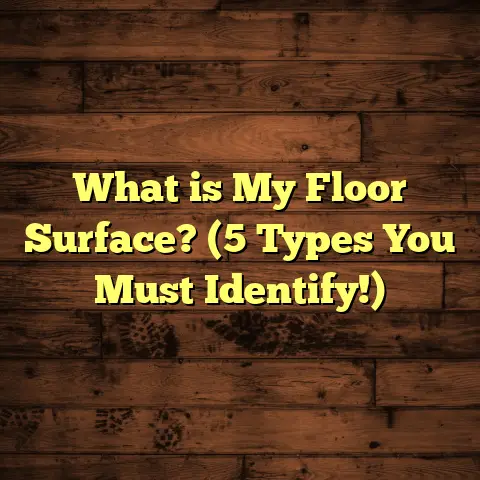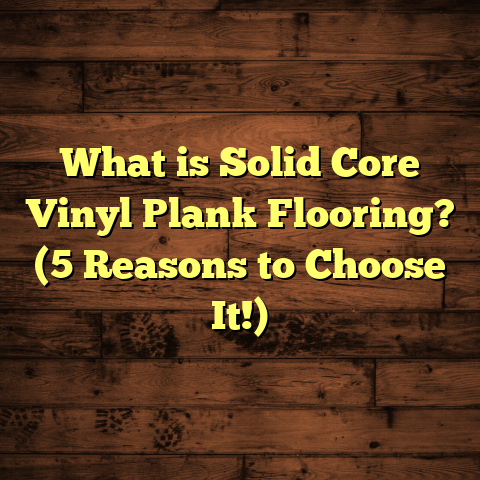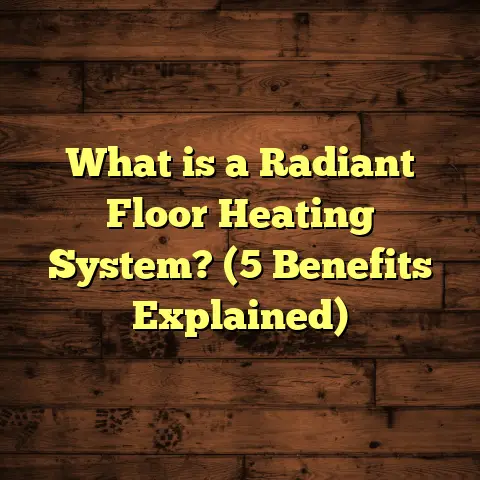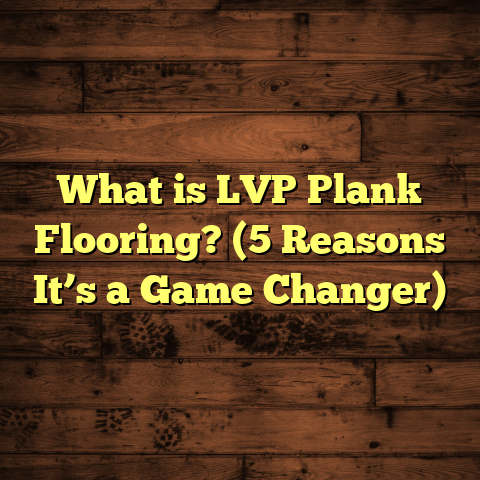What is Cheaper: Concrete Floor or Wood? (5 Key Cost Factors Inside)
What is Cheaper: Concrete Floor or Wood? (5 Key Cost Factors Inside)
If you’re standing on the fence about floors, wondering whether to go for concrete or wood, you’re not alone. I’ve helped countless homeowners and contractors wrestle with the same question. Flooring isn’t just about looks—it’s a big chunk of your budget and can affect your home’s vibe for decades. Picking the right option means balancing upfront costs with long-term value.
I remember one project in Portland where my client was torn. She loved the warmth of hardwood but was worried about the budget. We ran through every number together, from material prices to labor to upkeep. That experience taught me there’s no one-size-fits-all answer—only one that fits your unique situation. So, let’s get into what really moves the needle on cost between concrete and wood floors, so you can make a smart choice without guesswork.
What is Concrete Flooring and Wood Flooring?
Before breaking down costs, it’s important to understand what these floors are and why they differ so much in price and maintenance.
Concrete Flooring
Concrete floors start as a wet mix of cement, water, sand, and gravel poured into place. Once poured, it’s leveled and smoothed to create a hard surface. The raw slab can be left as is or finished in many ways: polished to a mirror shine, stained with color, textured with patterns, or sealed with protective coatings.
Concrete is extremely durable—often lasting 30 years or more if cared for properly. It’s common in basements, garages, commercial settings, and increasingly in modern homes for its sleek industrial look. Because concrete is poured onsite, the installation timeline depends on curing time (usually 3-7 days) to ensure hardness before foot traffic.
In my experience working on residential projects in California, polished concrete can transform a space—making it feel open and contemporary—but it requires skilled labor and specialized equipment which can increase costs.
Wood Flooring
Wood floors come mainly in two types: solid hardwood and engineered wood.
- Solid hardwood is made from a single piece of timber, usually 3/4 inch thick. It’s nailed or stapled onto a wooden subfloor. Species vary widely—from affordable pine to high-end walnut or exotic teak.
- Engineered wood consists of layers of plywood topped with a thin hardwood veneer. It’s more stable in humid conditions and can be installed via glue-down, nail-down, or floating methods.
Wood floors add warmth and character to any room but require more maintenance than concrete. You’ll also find installation times vary depending on acclimation (wood needs to adjust to indoor humidity), sanding, and finishing.
I once installed solid oak hardwood in a Chicago home where the winters caused the wood to shrink slightly, requiring seasonal care tips I shared with the homeowner to prevent gaps and cracks.
5 Key Cost Factors That Decide Which Floor is Cheaper
Now that we know what each floor involves, let’s get into the nitty-gritty of what affects the price.
1. Material Costs: How Much Does the Floor Itself Cost?
Material costs vary widely depending on quality, finish, and region. Here’s what I’ve found:
Concrete Material Pricing
- Basic concrete slab: $3 – $7 per sq ft
- Polished or stained concrete: $8 – $15 per sq ft
- Decorative overlays or stamping: $12 – $25 per sq ft
Concrete pricing depends heavily on aggregate quality, thickness (usually 4-6 inches for residential slabs), and additives like fiber reinforcement.
For example, in Florida’s humid climate, using air-entrained concrete to reduce cracking may add $1-$2 per sq ft.
When installing polished concrete in Austin recently, I saw material costs around $4.50 for basic slabs but finishing treatments nearly tripled that.
Wood Material Pricing
Wood prices hinge on species and grade:
- Affordable hardwoods (pine, maple): $5 – $8 per sq ft
- Mid-range hardwoods (oak, cherry): $8 – $12 per sq ft
- Exotic hardwoods (mahogany, teak): $12 – $20+ per sq ft
- Engineered wood: $4 – $8 per sq ft
In the Northeast U.S., hardwood prices often spike during winter due to supply chain slowdowns.
I remember sourcing walnut planks for a Boston client at $15/sq ft—almost double what I paid in Texas for oak.
Why Material Costs Matter
Material cost is the foundation of your budget. Even if installation is cheap, expensive materials can push totals high. Conversely, low-cost materials might need more maintenance or have shorter lifespans.
2. Installation Costs: Labor and Specialized Skills
Labor rates differ by region and difficulty:
Concrete Installation
- Pouring and finishing: $5 – $10 per sq ft
- Polishing/staining: Additional $3 – $7 per sq ft
- Decorative stamping/overlay: $12 – $25 per sq ft
Concrete requires heavy equipment like mixers, trowels, and sometimes grinders for polishing. Skilled labor is essential to avoid cracking or uneven surfaces.
In high-cost areas like NYC, labor can reach $12/sq ft due to union wages.
I’ve seen contractors rush concrete pours leading to cracking—costly repairs later—so choosing experienced crews pays off.
Wood Installation
- Solid hardwood: $4 – $8 per sq ft
- Engineered wood: $3 – $6 per sq ft
- Refinishing (sanding/staining): $1.50 – $4 per sq ft
Installation includes subfloor prep, acclimation time (engineered wood might skip this), cutting/planning boards, fastening, and finishing.
In suburban Chicago, I paid roughly $6/sq ft for oak installation including sanding and staining.
Installation Timeframes Impact Costs
Longer time means higher labor charges and possible disruption costs if you live onsite during renovation.
Concrete usually wraps up faster but requires curing downtime; wood takes longer due to acclimation and finishing steps.
3. Maintenance Costs Over Time: The True Long-Term Expense
People often forget maintenance when budgeting. Here’s what you’ll likely spend:
Concrete Maintenance
- Resealing every 2-3 years at approx. $0.50-$1/sq ft
- Cleaning with neutral pH cleaners
- Polished concrete can last decades with minimal upkeep
In a Seattle warehouse I worked on, concrete floors have been in use for 25 years with only two resealing cycles.
Wood Maintenance
- Refinishing every 7-10 years costing $1-$3/sq ft
- Regular sweeping/vacuuming to avoid scratches
- Immediate repair of water damage necessary to prevent warping
A client in Atlanta refinished her oak floors twice in 15 years at about $2/sq ft each time.
Comparing Lifespan Costs
Over 30 years:
- Concrete might require 10 resealings ($500 total for 1,000 sq ft)
- Hardwood may need 3 refinishings ($6,000 total for 1,000 sq ft)
Maintenance costs can tip the scale heavily toward concrete if you want low hassle.
4. Installation Speed and Project Timeline
When you’re renovating or building new construction, timing matters:
- Concrete slabs take about 3-7 days including curing.
- Polished/stained finishes add 1-3 days.
- Wood floors take at least 3 days plus acclimation time (up to two weeks).
- Solid hardwood requires sanding/staining adding several days.
In my experience managing projects in Los Angeles, faster concrete installation helped homeowners move in sooner—saving rental costs elsewhere.
If you’re tight on time but want wood’s appeal, engineered wood floors can speed things up because they need less acclimation.
5. Waste Factor & Subfloor Preparation Costs
Don’t overlook waste from cutting or errors:
Waste Factor
- Concrete typically includes about 5% over-pour allowance.
- Wood flooring waste runs 7-10%, sometimes more with complex room shapes.
If you have a 1,000 sq ft room:
- Concrete waste = ~50 sq ft extra.
- Wood waste = 70 – 100 sq ft extra material needed.
Subfloor Prep
Concrete slabs require minimal prep when poured new but may need leveling if poured over old slabs ($1-$3/sq ft).
Wood floors require flat subfloors free of moisture or rot; repairs can add several thousand dollars depending on damage extent.
A Midwest client had old wooden joists replaced before installing hardwood—adding nearly $4 per sq ft extra prep cost.
Additional Insights From My Projects & Research
Regional Price Differences Matter
In my work across multiple states—from Texas to New York to California—I noticed pricing swings:
| Location | Concrete Material + Install ($/sq ft) | Hardwood Material + Install ($/sq ft) |
|---|---|---|
| Texas | $9 – $13 | $12 – $18 |
| New York | $12 – $18 | $15 – $22 |
| California | $10 – $16 | $14 – $20 |
Labor scarcity or demand spikes can cause these variances quickly.
Case Study: Midwestern Basement Remodel
A client wanted a basement floor that wouldn’t be cold or damp. We compared:
- Polished concrete at about $12/sq ft installed.
- Engineered wood floor at about $15/sq ft installed plus moisture barrier prep.
Concrete was lower upfront but felt colder underfoot despite radiant heating. Engineered wood added warmth but cost more initially plus some ongoing care.
The client chose engineered wood for comfort despite the price bump—showing how cost isn’t always everything.
Environmental Impact & Resale Value Considerations
Concrete floors are energy efficient as they retain heat well but are less eco-friendly due to cement production emissions.
Wood floors are renewable if sourced responsibly but require more resources in maintenance/refinishing over time.
Resale value tends to favor wood floors in residential homes because of their classic appeal; concrete floors may appeal more in modern or industrial styles but could narrow your buyer pool.
How FloorTally Helps Me Nail Costs Every Time
I’ve mentioned FloorTally before because it’s been a lifesaver when estimating projects quickly without missing hidden expenses.
When I punch in room dimensions, choose finishes (polished concrete vs oak hardwood), add labor rates specific to city zones like Denver or Boston—it spits out a detailed cost breakdown including waste percentages and maintenance projections.
This helps clients see where their dollars go instead of vague guesses. Plus, testing multiple scenarios lets me compare options side-by-side easily.
One time I used FloorTally for a client in Phoenix who was debating between basic concrete slab vs mid-grade engineered wood—seeing the total cost difference helped them commit confidently without second thoughts.
Final Thoughts: What Really Decides Which Floor is Cheaper?
The answer boils down to what you prioritize:
| Factor | Concrete Advantage | Wood Advantage |
|---|---|---|
| Upfront Material Cost | Usually lower | Often higher |
| Installation Complexity | Requires specialized labor | Can be DIY or pro-installed |
| Maintenance & Repairs | Low maintenance | Higher upkeep |
| Installation Time | Faster | Longer |
| Aesthetic & Resale Value | Industrial look | Classic warmth |
For most budget-conscious homeowners wanting durability with minimal fuss—concrete wins on cost over time.
But if you value ambiance and are ready for upkeep costs, wood flooring brings timeless appeal even if pricier upfront and over years.
Remember my Portland client? She chose wood after all because it felt “homey” despite the higher numbers. That’s why it pays to weigh both numbers and feelings when picking floors!
If you want me to share specific breakdowns by city or walk through how I’d plan your project using FloorTally step-by-step just ask! Flooring decisions are personal—and getting clear numbers helps make them easier.





